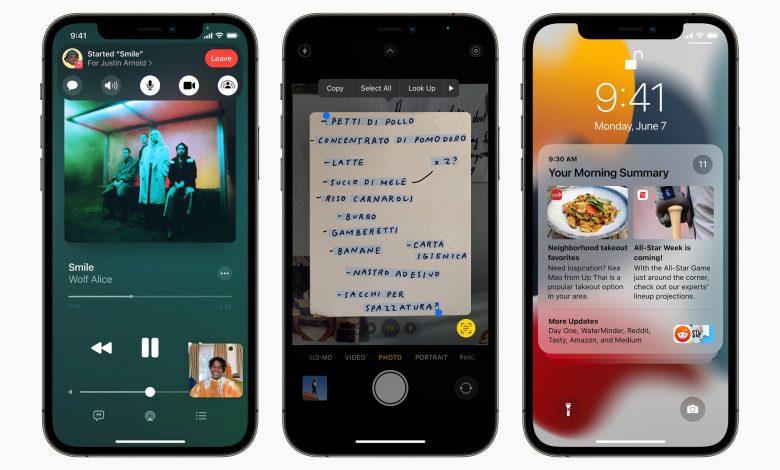
iOS is the name of the operating system that runs the iPhone and iPod touch. It’s the core software that comes loaded on all devices to allow them to run and support other apps. The iOS is to the iPhone what Windows is to PCs or macOS is to Macs.
Below you’ll find a history of each version of the iOS when it was released, and what it added to the platform. Click the name of the iOS version, or the More link at the end of each blurb, for more in-depth information about that version.
See our article What is iOS? for a lot more on this innovative mobile operating system and how it works.
Contents
iOS 15
Support ended: n./a
Current version: 15.0.2, released Oct. 11, 2021
Initial version: 15.0, released Sept. 24, 2021
Much like iOS 14, iOS 15 is more of a collection of improvements to the iPhone platform than it is a themed release. Generally speaking, iOS 15 moves forward a number of important things Apple has been working on for a number of releases: Increases security and privacy, blocks more ad tracking, improves Siri and the camera app, and much more.
Some of the biggest steps forward are influenced by the recent remote-work trend. Features in that area include improvements to FaceTime audio, support for FaceTime conferencing on the web and Android, improvements to the Messages app, and more.
Key New Features:
- FaceTime received numerous improvements aimed at improving the experience of using the app and expanding the audience for it, including:
- SharePlay allows people on a FaceTime video call to watch video or listen to audio together, and share screens
- Spatial Audio brings Apple’s more-natural, 3D audio experience to improve the naturalness of FaceTime sound
- Enhanced Mic Modes allow you to isolate your voice from background noise to improve audio quality
- Portrait Mode brings this terrific still-photos feature to video to blur your background
- Cross-Platform support allows you to invite anyone to a FaceTime call with a link and for them to join from a web browser or Android devices.
- Focus adds a set of smart notification and communication s settings based on what you’re doing at that moment.
- The Photos app gains major improvements such as:
- Live Text lets the app detect text inside your photos and convert it to text that can be copied and pasted, or phone numbers that can be tapped to call
- Visual search lets you search within the Photos app for text embedded your photos.
- In keeping with Apple’s ongoing commitment to user privacy, iOS 15 adds:
- App Privacy Report lets you know what permissions each of your apps has, how often it accesses your data, and what third-party domains the app has contacted.
- Mail Privacy Protection blocks tracking pixels, hides your IP address from marketers, and blocks the connection of your data from email with other data sources.
- On-device Siri means that Siri recordings are no longer sent to or stored in the cloud. Siri works completely on your iPhone, and now works offline.
- Support for the iCloud+ service that adds new Homekit and VPN-style features.
- Notifications scheduling and summary.
- Improved driving directions in Maps.
- A redesigned experience and features for managing tabs and groups of tabs in Safari.
- Better ways to find content shared with you and to share medical data from the Health app with your family.
Dropped Support For:
iOS 14
Support ended: n/a
Current version: 14.6, released May 24, 2021
Initial version: 14.0, released Sept. 17, 2020
There’s no single major change or theme to the changes introduced with iOS 14. Instead, iOS 14 is a collection of numerous small and medium-sized changes to the user interface, features, and overall ease of use that add up to making the experience of using an iPhone even better.
Maybe the most notable changes are around customization, thanks to the addition of Homescreen Widgets, the ability to choose default apps in some cases, and improved privacy controls.
Key New Features:
- Homescreen Widgets for customized home screens and shortcuts.
- Smart Stacks that deliver different Homescreen Widgets at different times of the day based on your habits.
- Set third-party apps as default for email and web browser apps.
- App Library, a new way of organizing apps and keeping your home scree neat
- App Clips
- Picture in picture mode
- Improved privacy features to block tracking online.
- Built-in language translation for 11 languages.
- Spatial audio for AirPods delivers surround sound, along with other AirPods improvements.
- Design changes allow phone calls and FaceTime calls to take up less space on the screen and allow you to do other things at the same time.
- Numerous improvements for group texts in iMessage, including threaded replies and mentions.
Dropped Support For:
- None. iOS 14 supports the same set of devices as iOS 13
Support ended: n/a
Current version: 13.7, release Sept. 1, 2020.
Initial version: 13.0, released Sept. 19, 2019
Perhaps the biggest change introduced with iOS 13 is that the OS no longer runs on the iPad. That’s due to the release of iPadOS (which begins with version 13). That’s a new OS dedicated to the making the iPad a more useful productivity device and a potential laptop replacement. It’s based on iOS 13 and has many of the same features, but also adds iPad-specific items.
Beyond that, iOS 13 shores up some core features, including launching apps faster, unlocking devices with Face ID faster, and overhauling pre-installed apps like Reminders, Notes, Safari, and Mail. Maybe the most obvious new feature is the Dark Mode, but the changes range much wider than that and further bolster the already-strong OS.
Key New Features:
- System-wide Dark Mode
- Sign In With Apple user account system
- New privacy and security options
- New Portrait Lighting options
- Look Around, a Google Street View-style feature for Apple Maps
- New, improved Siri voice
- Overhauled stock apps like Reminders and Notes
Dropped Support For:
- iPad (due to the release of iPadOS)
- 6th Gen. iPod touch
- iPhone 6 series
- iPhone 5S
Support ended: n/a
Current version: 12.4.8. It was released July 15, 2020
Initial version: It was released on September 17, 2018
The new features and improvements added in iOS 12 aren’t as extensive or revolutionary as in some previous updates to the OS. Instead, iOS 12 focused more on making refinements to commonly used features and on adding wrinkles that improve how people use their devices.
Some of the key features of iOS 12 included improvements to Siri like Siri Shortcuts, enhanced Augmented Reality with ARKit 2, and giving users and parents ways to monitor and control their device use with Screen Time.
Key New Features:
- Grouped Notifications
- Screen Time
- ARKit 2
- Siri improvements, including Siri Shortcuts and multi-step actions
- Memoji, a personalized kind of Animoji
Dropped Support For:
Support ended: n/a
Current version: 11.4.1. It was released on July 9, 2018
Initial version: It was released on September 19, 2017
The iOS was originally developed to run on the iPhone. Since then, it’s been expanded to support the iPod touch and iPad (and versions of it even power the Apple Watch and Apple TV). In iOS 11, the emphasis shifted from the iPhone to the iPad.
Sure, iOS 11 contains lots of improvements for the iPhone, but its major focus is turning the iPad Pro series models into legitimate laptop replacements for some users.
This is done through a series of changes designed to make the iOS running on iPad a lot more like a desktop operating system. These changes include all new drag and drop support, split screen apps and multiple workspaces, a file browser app, and support for notation and handwriting with the Apple Pencil.
Key New Features:
Dropped Support For:
Support ended: 2019
Current version: 10.3.4. It was released on July 22, 2019
Initial version: It was released on Sept. 13, 2016
The ecosystem that Apple built around the iOS has long been referred to as a “walled garden” because it’s a very pleasant place to be on the inside, but it’s hard to gain access to. This was reflected in the many ways Apple locked down the interface of the iOS the options it gave to apps.
Cracks began to show in the walled garden in iOS 10, and Apple put them there.
The major themes of iOS 10 were interoperability and customization. Apps could now communicate directly with each other on a device, allowing one app to use some features from another without opening the second app. Siri became available to third-party apps in new ways. There were even apps built into iMessage now.
Beyond that, users now had new ways to customize their experiences, from (finally!) being able to delete built-in apps to new animations and effects to punctuate their text messages.
Key New Features:
Dropped Support For:
- iPhone 4S
- 5th gen. iPod touch
- iPad 2
- 1st gen. iPad mini
Support ended: 2018
Final version: 9.3.9. It was released on July 22, 2019
Initial version: It was released on Sept. 16, 2015
After a few years of major changes to both the interface and technical foundation of the iOS, many observers began to charge that the iOS was no longer the stable, dependable, solid performer it had once been. They suggested that Apple should focus on shoring up the foundation of the OS before adding new features.
That’s just what the company did with iOS 9. While it did add some new features, this release was generally aimed at solidifying the foundation of the OS for the future.
Major improvements were delivered in speed and responsiveness, stability, and performance on older devices. iOS 9 proved to be an important refocusing that laid the groundwork for the bigger improvements delivered in iOS 10 and 11.
Key New Features:
Dropped Support For:
Support ended: 2016
Final version: 8.4.1. It was released on Aug. 13, 2015
Initial version: It was released on Sept. 17, 2014
More consistent and stable operation returned to the iOS in version 8.0. With the radical changes of the last two versions now in the past, Apple once again focused on delivering major new features.
Among these features was its secure, contactless payment system Apple Pay and, with the iOS 8.4 update, the Apple Music subscription service.
There were continued improvements to the iCloud platform, too, with the addition of the Dropbox-like iClould Drive, iCloud Photo Library, and iCloud Music Library.
Key New Features:
Dropped Support For:
Support ended: 2016
Final version: 7.1.2. It was released on June 30, 2014.
Initial version: It was released on Sept. 18, 2013
Like iOS 6, iOS 7 was met with substantial resistance upon its release. Unlike iOS 6, though, the cause of unhappiness among iOS 7 users wasn’t that things didn’t work. Rather, it was because things had changed.
After the firing of Scott Forstall, iOS development was overseen by Jony Ive, Apple’s head of design, who had previously only worked on hardware. In this version of the iOS, Ive ushered in a major overhaul of the user interface, designed to make it more modern.
While the design was indeed more modern, its small, thin fonts were hard to read for some users and frequent animations caused motion sickness for others. The design of the current iOS is derived from the changes made in iOS 7. After Apple made improvements, and users became accustomed to the changes, complaints subsided.
Key New Features:
Dropped Support For:
- iPhone 3GS
- iPhone 4, iPhone 4S, 3rd gen. iPad, and iPad 2 couldn’t use all features of iOS 7
iOS 6
Support ended: 2015
Final version: 6.1.6. It was released on Feb. 21, 2014
Initial version: It was released on Sept. 19, 2012
Controversy was one of the dominant themes of iOS 6. While this version introduced the world to Siri — which, despite being later surpassed by competitors, was a truly revolutionary technology — problems with it also led to major changes.
The driver of these problems was Apple’s increasing competition with Google, whose Android smartphone platform was posing a threat to the iPhone. Google had supplied the Maps and YouTube apps pre-installed with the iPhone since 1.0. In iOS 6, that changed.
Apple introduced its own Maps app, which was badly received due to bugs, bad directions, and problems with certain features. As part of the company’s efforts to solve the problems, Apple CEO Tim Cook asked the head of iOS development, Scott Forstall, to make a public apology. When he refused, Cook fired him. Forstall had been involved with the iPhone since before the first model, so this was a profound change.
Key New Features:
Dropped Support For:
- None, but iPhone 3GS, iPhone 4, and iPad 2 couldn’t use all features of iOS 6
Support ended: 2014
Final version: 5.1.1. It was released on May 7, 2012
Initial version: It was released on Oct. 12, 2011
Apple responded to the growing trend of wirelessness, and cloud computing, in iOS 5, by introducing essential new features and platforms. Among those was iCloud, the ability to activate an iPhone wirelessly (previously it had required a connection to a computer), and syncing with iTunes via Wi-Fi.
More features that are now central to the iOS experience debuted here, including iMessage and Notification Center.
With iOS 5, Apple dropped support for the iPhone 3G, 1st gen. iPad, and 2nd and 3rd gen. iPod touch.
Key New Features:
Dropped Support For:
- iPhone 3G
- 1st gen. iPad
- 2nd gen. iPod touch
- 3rd gen. iPod touch
Support ended: 2013
Final version: 4.3.5. It was released on July 25, 2011
Initial version: It was released on June 22, 2010
Many aspects of the modern iOS began to take shape in iOS 4. Features that are now widely used debuted in various updates to this version, including FaceTime, multitasking, iBooks, organizing apps into folders, Personal Hotspot, AirPlay, and AirPrint.
Another important change introduced with iOS 4 was the name “iOS” itself. As noted earlier, the iOS name was unveiled for this version, replacing the previously used “iPhone OS” name.
This was also the first version of the iOS to drop support for any iOS devices. It was not compatible with the original iPhone or the 1st generation iPod touch. Some older models that were technically compatible were not able to use all features of this version.
Key New Features:
Dropped Support For:
- Original iPhone
- 1st Gen. iPod touch
iOS 3
Support ended: 2012
Final version: 3.2.2. It was released on Aug. 11, 2010
Initial version: It was released on June 17, 2009
The release of this version of the iOS accompanied the debut of the iPhone 3GS. It added features including copy and paste, Spotlight search, MMS support in the Messages app, and the ability to record videos using the Camera app.
Also notable about this version of the iOS is that it was the first to support the iPad. The 1st generation iPad was released in 2010, and version 3.2 of the software came with it.
Key New Features:
iOS 2
Support ended: 2011
Final version: 2.2.1. It was released on January 27, 2009
Initial version: It was released on July 11, 2008
One year after the iPhone became a bigger hit than almost anyone projected, Apple released iOS 2.0 (then called iPhone OS 2.0) to coincide with the release of the iPhone 3G.
The most profound change introduced in this version was the App Store and its support for real third-party apps (rather than web apps). Around 500 apps were available in the App Store at launch. Hundreds of other crucial improvements were also added.
Other important changes introduced in the 5 updates iPhone OS 2.0 included podcast support and public transit and walking directions in Maps (both in version 2.2).
Key New Features:
iOS 1
Support ended: 2010
Final version: 1.1.5. It was released on July 15, 2008
Initial version: It was released on June 29, 2007
The one that started it all, which shipped pre-installed on the original iPhone.
This version of the operating system wasn’t called the iOS at the time it launched. From versions 1-3, Apple referred to it as the iPhone OS. The name shifted to iOS with version 4.
It’s hard to convey to modern readers who have lived with the iPhone for years how profound a breakthrough this version of the operating system was. Support for features like the multitouch screen, Visual Voicemail, and iTunes integration were significant advances.
While this initial release was a major breakthrough at the time, it lacked many of the features that would come to be closely associated with the iPhone in the future, including support for real third-party apps. Pre-installed apps included Calendar, Photos, Camera, Notes, Safari, Mail, Phone, and iPod (which was later split into the Music and Videos apps).
Version 1.1, which was released in Sept. 2007 was the first version of the software compatible with the iPod touch.
Key New Features:
Thanks for letting us know!
Tell us why!







